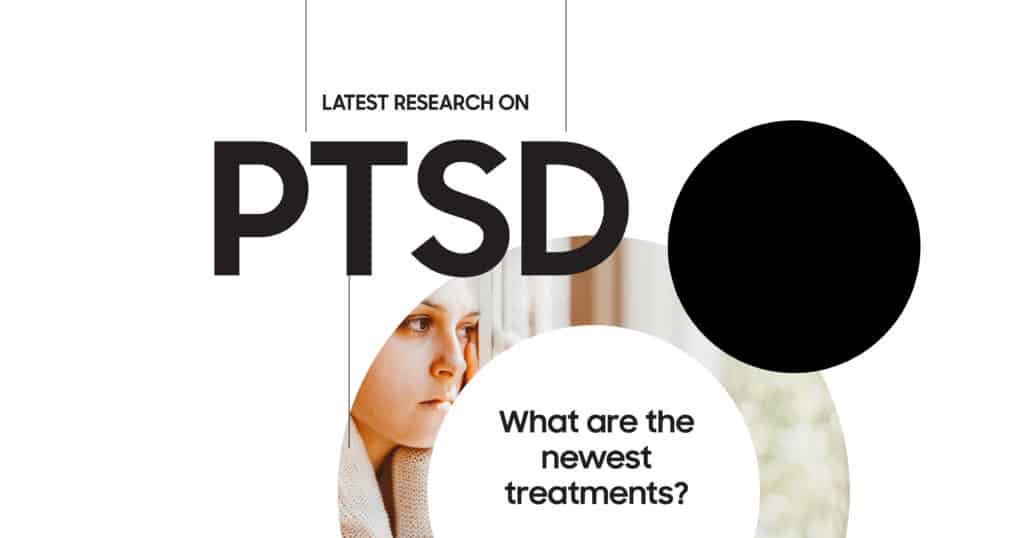Post-traumatic stress disorder (PTSD) is a challenging mental health condition that impacts millions globally. It arises from experiencing or witnessing a traumatic event, causing intense anxiety, flashbacks, and persistent thoughts related to the event.
As our understanding of PTSD evolves, so do the treatment options available. This article delves into the latest research on PTSD and explores the newest treatments that are making a difference in the lives of those affected.
Understanding PTSD: An Overview
What is PTSD?
Post-traumatic stress disorder (PTSD) is a mental health condition that can develop in people who have gone through or seen a traumatic event like a natural disaster, a severe accident, a terrorist attack, war, sexual assault, or other violent assaults. It is classified as a psychiatric disorder affecting the mental health and daily functioning of individuals.
PTSD can affect anyone, but certain factors may increase the risk, such as a history of mental illness, acute stress disorder, traumatic brain injury, substance abuse, or the lack of a support system.
Symptoms of PTSD
PTSD symptoms typically fall into four categories:
- Intrusive memories: Upsetting and unwanted memories of the traumatic event that keep coming back.
- Avoidance: Trying to avoid places, people, or activities that remind you of the trauma.
- Adverse changes in thinking and mood: Feeling down on yourself or others, losing hope, having trouble remembering things, and struggling with relationships.
- Changes in physical and emotional reactions: Feeling jumpy, constantly on alert, taking risks, having difficulty sleeping, and finding it hard to concentrate.
Traditional PTSD Treatments
Psychotherapy
- Cognitive Behavioral Therapy (CBT): CBT is the most common form of therapy for PTSD, focusing on changing the thought patterns that are disturbing the patient’s life.
- Exposure Therapy: This helps patients safely face what they find frightening so they can learn to cope with it effectively.
- Eye Movement Desensitization and Reprocessing (EMDR): EMDR involves guided eye movements to help process traumatic memories and change how they are stored in the brain.
Medications
- Selective Serotonin Reuptake Inhibitors (SSRIs): Medicines like sertraline (Zoloft) and paroxetine (Paxil) are commonly prescribed for PTSD.
- Other Medications: Prazosin, typically used to treat high blood pressure, can help with PTSD-related nightmares.
Latest Research and Emerging Treatments
Advances in Psychotherapy
Virtual Reality Exposure Therapy (VRET)
Virtual Reality Exposure Therapy (VRET) is an emerging treatment that uses virtual reality technology to provide controlled exposure to trauma-related stimuli. This method has shown promise in helping patients confront and process traumatic experiences in a safe and controlled environment. Additional studies have shown VRET to be particularly effective in military veterans suffering from chronic PTSD.
Cognitive Processing Therapy (CPT)
Cognitive processing therapy (CPT) is a type of cognitive-behavioral therapy designed explicitly for PTSD. Recent research suggests that CPT can be highly effective in helping patients challenge and modify unhelpful beliefs related to trauma. Trauma-focused therapies like CPT are now considered frontline treatments in mental health care.
Innovations in Medication
MDMA-Assisted Psychotherapy
MDMA-assisted psychotherapy is currently one of the most talked-about new treatments for PTSD. Research led by organizations like MAPS (Multidisciplinary Association for Psychedelic Studies) has shown that MDMA, when used in conjunction with psychotherapy, can significantly reduce PTSD symptoms. Clinical improvement has been noted in participants of these clinical studies.
Ketamine Infusions
Ketamine, traditionally used as an anesthetic, is being explored as a treatment for PTSD due to its rapid-acting antidepressant effects. Studies indicate that ketamine infusions can provide immediate relief from severe PTSD symptoms, making it a promising option for those with acute stress disorder and chronic PTSD.
Novel Approaches in Neuromodulation
Transcranial Magnetic Stimulation (TMS)
Transcranial Magnetic Stimulation (TMS) is a non-invasive procedure that uses magnetic fields to stimulate nerve cells in the brain. TMS has been approved for treating depression and is now being investigated for its benefits in treating PTSD. Wayne State University is among the institutions conducting longitudinal studies on the effectiveness of TMS for PTSD.
Vagus Nerve Stimulation (VNS)
Vagus Nerve Stimulation (VNS) involves delivering electrical impulses to the vagus nerve. Early research suggests that VNS can help reduce PTSD symptoms by modulating brain activity associated with stress and anxiety. Future studies are expected to further explore the efficacy of VNS in managing PTSD symptoms.
Alternative and Complementary Therapies
Acupuncture
Acupuncture, a traditional Chinese medicine practice, is gaining attention as a complementary therapy for PTSD. Some studies have shown that acupuncture can help reduce anxiety and improve overall well-being in PTSD patients. Present-centered therapy has also been used in conjunction with acupuncture for better treatment outcomes.
Yoga and Mindfulness
Mindfulness practices, including yoga and meditation, are increasingly being recommended for PTSD. These practices can help people become more aware of their thoughts and feelings and promote a sense of control. Professor of psychiatry and associate professor studies have shown significant improvements in posttraumatic stress symptoms through these practices.
Understanding the Science Behind New Treatments
The Role of Neuroplasticity
One of the critical areas of research in PTSD treatment is neuroplasticity, the brain’s ability to reorganize itself by forming new neural connections. Treatments that promote neuroplasticity, such as TMS and MDMA-assisted therapy, are showing promise in helping the brain recover from the effects of trauma. Brain activation studies have revealed changes in brain pathways associated with trauma recovery.
Biomarkers and Personalized Medicine
Researchers are also focusing on identifying biomarkers for PTSD, which could lead to more personalized and effective treatments. Biomarkers are measurable indicators of the presence of some disease state, and understanding these could allow for treatments tailored to an individual’s specific needs. Studies published in JAMA Psychiatry and Mol Psychiatry highlight the importance of biomarkers in the future of PTSD treatment.
How to Access New PTSD Treatments
Clinical Trials
Participating in clinical trials can be a way to access ways in cutting-edge treatments for PTSD. These trials are crucial for advancing our understanding of the disorder and developing new therapies. National Center for PTSD frequently updates information on ongoing clinical studies and their locations.
Seeking Specialized Care
Finding a cognitive health professional who specializes in PTSD and is knowledgeable about the latest treatments can make a significant difference. Specialized care providers are more likely to be aware of and have access to new and emerging therapies. Consulting with experts from reputable institutions like Temple University and Boston University can provide access to advanced treatment options.
FAQs
What is the most effective treatment for PTSD?
The effectiveness of PTSD treatments varies from person to person. Cognitive Behavioral Therapy and medications like SSRIs are traditionally effective, but new treatments such as MDMA-assisted psychotherapy and TMS are showing great promise. Stein MB and Glassman LH have conducted significant research in this area.
Are there any natural remedies for PTSD?
While natural remedies should not replace traditional treatments, practices such as yoga, mindfulness, and acupuncture can complement conventional PTSD treatments and help alleviate symptoms. These practices can aid in emotional regulation and symptom reduction.
How long does it take to see improvements in PTSD symptoms with new treatments?
The time frame for seeing improvements varies. Some treatments, like ketamine infusions, can provide rapid relief, while others, like psychotherapy, may take several weeks or months to show significant benefits. Studies in Transl Psychiatry have explored the varying timelines of clinical improvement.
Can PTSD be cured entirely?
While there is no definitive cure for PTSD, many treatments can help manage and significantly reduce symptoms, allowing individuals to lead fulfilling lives. Research on reactive attachment disorder and social engagement disorder provides insights into long-term management strategies.
Conclusion
The landscape of PTSD treatment is rapidly evolving, with new research uncovering innovative therapies that offer hope to those affected by this challenging disorder. From advancements in psychotherapy and medication to novel approaches in neuromodulation and complementary therapies, the future of PTSD treatment looks promising.
Staying current with the latest research and consulting with specialized healthcare providers can help individuals access the most effective treatments available, paving the way for better mental health and quality of life.





